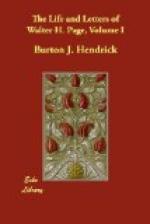One was to hand the possessions back to Spain, who in a four hundred years’ experiment had demonstrated her unfitness to govern them; another was to give the islands their independence, which would have meant merely an indefinite continuance of anarchy. It is one of the greatest triumphs of American statesmanship that it discovered a more satisfactory solution. Essentially, the new plan was to establish in these undeveloped and politically undisciplined regions the fundamental conditions that may make possible the ultimate creation of democratic, self-governing states. It was recognized that constitutions and election ballots in themselves did not necessarily imply a democratic order. Before these there must come other things that were far more important, such as popular education, scientific agriculture, sanitation, public highways, railroads, and the development of the resources of nature. If the backward peoples of the world could be schooled in such a preliminary apprenticeship, the time might come when the intelligence and the conscience of the masses would be so enlightened that they could be trusted with independence. The labour of Leonard Wood in Cuba, and of other Americans in the Philippines, had apparently pointed the way to the only treatment of such peoples that was just to them and safe for mankind.
With the experience of Cuba and the Philippines as a guide, it is not surprising that the situation in Mexico appealed to many Americans as opening a similar opportunity to the United States. The two facts that outstood all others were that Mexico, in her existing condition of popular ignorance, could not govern herself, and that the twentieth century could not accept indefinitely a condition of disorder and bloodshed that had apparently satisfied the nineteenth. The basic difficulty in this American republic was one of race and of national character. The fact that was constantly overlooked was that Mexico was not a Caucasian country: it was a great shambling Indian Republic. Of its 15,000,000 people less than 3,000,000 were of unmixed white blood, about 35 per cent. were pure Indian, and the rest represented varying mixtures of white and aboriginal stock. The masses had advanced little in civilization since the days of Cortez. Eighty per cent. were illiterate;




